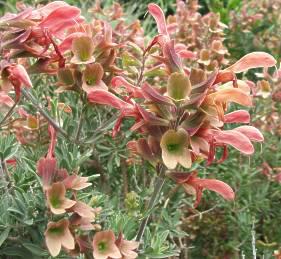Salvia lanceolata

Description
This upright shrub has light green leaves and dull red, crimson or grey-blue flower, with a shape is typical of the related wild sages.The colour of the flowers and the shape of the flower indicate that this salvia is pollinated by birds rather than bees like the other salvias. There is a mechanism in the flower than tips the stamen with the pollen onto the birds head once it has inserted in into the plant, thus enabling it to be transferred with the bird to other flowers of this species that the birds visit.
The plants of this family are widely used in cooking and was most likely used historically in traditional medicine.
Propagation instructions - cuttings
Stem cuttings should be taken in spring, from new growth that is just firming up into semi-hardwood. Use rooting hormone and a mist unit with bottom heat to ensure a higher success rate.
Propagation instructions - seeds
Propagate by seed or cutting. Sow seeds in a well drained soil from which they will germinate quickly. Pot when true leaves appear.
Sources and references
Scientific name
Salvia lanceolata
Common name(s)
Rusty sage
